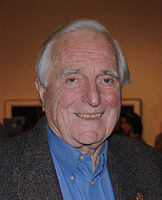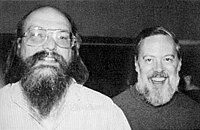University of California, Berkeley: Difference between revisions
Altanner1991 (talk | contribs) m →Rankings: update |
Altanner1991 (talk | contribs) →Rankings: rm rankings, these are determined by unique criteria or methods and not on the basis of generally-available data, so can not be listed here – please see Wikipedia:Copyright in lists Tag: Reverted |
||
| Line 215: | Line 215: | ||
| USNWR_W = 4 |
| USNWR_W = 4 |
||
}} |
}} |
||
{{col-break}} |
|||
{| class="wikitable sortable collapsible collapsed" style="float:right" "text-align:center" |
|||
|- |
|||
! colspan=4 style="{{CollegePrimaryStyle|California Golden Bears|color=white}}" |National Program Rankings<ref name="USNWR Grad School Rankings">{{cite magazine|title=University of California—Berkeley – U.S. News Best Grad School Rankings|magazine=U.S. News & World Report|access-date=April 26, 2020|url=https://www.usnews.com/best-graduate-schools/university-of-california-berkeley-110635/overall-rankings}}</ref> |
|||
|- |
|||
! Program |
|||
! Ranking |
|||
|- |
|||
| English || 1 |
|||
|- |
|||
| Psychology || 1 |
|||
|- |
|||
| Economics || 1 |
|||
|- |
|||
| Sociology || 1 |
|||
|- |
|||
| Computer Science || 1 |
|||
|- |
|||
| Biological Sciences || 1 |
|||
|- |
|||
| Earth Sciences || 2 |
|||
|- |
|||
| Chemistry || 2 |
|||
|- |
|||
| Mathematics || 2 |
|||
|- |
|||
| {{tooltip|Statistics|Biostatistics programs are not considered in the No. 2 ranking. UC Berkeley is No. 12 when Biostatistics programs are considered.}} || 2 |
|||
|- |
|||
| Public Affairs || 4 |
|||
|- |
|||
| Social Work || 3 |
|||
|- |
|||
| Clinical Psychology || 3 |
|||
|- |
|||
| Physics || 3 |
|||
|- |
|||
| Engineering || 3 |
|||
|- |
|||
| Political Science || 4 |
|||
|- |
|||
| History || 4 |
|||
|- |
|||
| Business || 7 |
|||
|- |
|||
| Public Health || 8 |
|||
|- |
|||
| Law || 9 |
|||
|- |
|||
| Fine Arts || 15 |
|||
|- |
|||
| Education || 19 |
|||
|} |
|||
{{col-break}} |
|||
{| class="wikitable sortable collapsible collapsed" style="float:right" "text-align:center" |
|||
|- |
|||
! colspan=4 style="{{CollegePrimaryStyle|California Golden Bears|color=white}}" |Global Subject Rankings<ref name="USNWR Global Univ Rankings">{{cite magazine|title=University of California—Berkeley – U.S. News Best Global University Rankings|magazine=U.S. News & World Report|access-date=April 26, 2020|url=https://www.usnews.com/education/best-global-universities/university-of-california-berkeley-110635}}</ref> |
|||
|- |
|||
! Program |
|||
! Ranking |
|||
|- |
|||
| Chemistry || 1 |
|||
|- |
|||
| Environment/Ecology || 3 |
|||
|- |
|||
| Space Science || 3 |
|||
|- |
|||
| Physics || 3 |
|||
|- |
|||
| Economics & Business || 3 |
|||
|- |
|||
| Biology & Biochemistry || 5 |
|||
|- |
|||
| Plant & Animal Science || 4 |
|||
|- |
|||
| Civil Engineering || 4 |
|||
|- |
|||
| Mathematics || 7 |
|||
|- |
|||
| Materials Science || 6 |
|||
|- |
|||
| Geosciences || 7 |
|||
|- |
|||
| Engineering || 7 |
|||
|- |
|||
| Arts & Humanities || 12 |
|||
|- |
|||
| Microbiology || 9 |
|||
|- |
|||
| Molecular Biology & Genetics || 19 |
|||
|- |
|||
| Social Sciences & Public Health || 14 |
|||
|- |
|||
| Neuroscience & Behavior || 20 |
|||
|- |
|||
| Computer Science || 5 |
|||
|- |
|||
| Psychiatry/Psychology || 31 |
|||
|- |
|||
| Electrical & Electronic Engineering || 35 |
|||
|- |
|||
| Immunology || 65 |
|||
|- |
|||
| Mechanical Engineering || 67 |
|||
|- |
|||
| Clinical Medicine || 137 |
|||
|} |
|||
{{col-end}} |
|||
{| class="wikitable mw-collapsible mw-collapsed" |
|||
|- |
|||
! Rank !! QS World Ranking by Subject<ref>{{Cite web |title=QS World University Rankings by Subject 2022 |url=https://www.topuniversities.com/subject-rankings/2022 |access-date=2022-07-26 |website=Top Universities |language=en}}</ref> |
|||
|- |
|||
| 4 || Arts & Humanities |
|||
|- |
|||
| 9 || Engineering & Technology |
|||
|- |
|||
| 19 || Life Sciences & Medicine |
|||
|- |
|||
|8 |
|||
|Natural Sciences |
|||
|- |
|||
| 8 || Social Sciences & Management |
|||
|} |
|||
Nationally, the 2018–19 ''Center for World University Rankings'' (CWUR) ranked the university the top public university in the nation and fourth overall based on quality of education, alumni employment, quality of faculty, publications, influence, and citations.<ref>{{cite web|url=https://cwur.org/2018-19/usa.php|title=USA—CWUR World University Rankings 2018–2019|publisher=Center for World University Rankings|access-date=September 1, 2020}}</ref> The 2021 ''Forbes'' [[America's Top Colleges]] report ranked Berkeley #1 among 600 private and public universities and liberal arts colleges in the United States.<ref>{{Cite web |title=Forbes America's Top Colleges List 2021 |url=https://www.forbes.com/top-colleges/ |access-date=2021-09-11 |website=Forbes |language=English}}</ref> For 2015 ''[[Kiplinger]]'' ranked Berkeley the 4th best-value public university in the nation for in-state students, and 6th for out-of-state students.<ref>{{cite web |url=http://www.kiplinger.com/tool/college/T014-S001-kiplinger-s-best-values-in-public-colleges/index.php |publisher=The Kiplinger Washington Editors, Inc. |title=Kiplinger's Best College Values |date=December 2014 |access-date=November 7, 2015}}</ref> The ''Money Magazine'' Best Colleges ranking for 2015 ranked Berkeley 9th in the United States, based on educational quality, affordability and alumni earnings.<ref>{{cite web |title=Money's Best Colleges |url=https://best-colleges.time.com/money/full-ranking#/list |access-date=November 7, 2015 |work=Money}}</ref> For 2021, [[Quacquarelli Symonds|''QS'']] "World University Rankings: USA" places Berkeley fourth among all US universities and first among publics.<ref>{{Cite web |title=QS World University Rankings: USA 2021 |url=https://www.topuniversities.com/university-rankings/usa-rankings/2021 |access-date=2022-08-27 |website=Top Universities |language=en}}</ref> In 2014, ''The Daily Beast''{{'s}} Best Colleges report ranked Berkeley 11th in the country.<ref>{{cite news|title=College Rankings 2014|newspaper=The Daily Beast|date=November 6, 2014|url=http://www.thedailybeast.com/articles/2014/11/06/the-daily-beast-s-down-and-dirty-guide-to-the-best-colleges-2014.html|publisher=The Daily Beast Company LLC|access-date=November 7, 2015|last1=Zadrozny|first1=Brandy}}</ref> The 2013 ''Top American Research Universities'' report by the [[Center for Measuring University Performance]] ranked Berkeley 8th overall, 5th in resources, faculty, and education, 9th in resources and education, and 1st in education.<ref>{{cite web|title=The Top American Research Universities |url=http://mup.asu.edu/Top-American-Research-Universities-2013-Annual-Report-MUP-2015-02-13.pdf |website=The Center for Measuring University Performance |publisher=The Center for Measuring University Performance |access-date=November 7, 2015 |url-status=dead |archive-url=https://web.archive.org/web/20160129174528/https://mup.asu.edu/Top-American-Research-Universities-2013-Annual-Report-MUP-2015-02-13.pdf |archive-date=January 29, 2016}}</ref> The 2019–20 [[U.S. News & World Report Best Colleges Ranking|''U.S. News & World Report''{{'}}s Best Colleges Ranking]] places Berkeley second among public universities and 22nd among national universities.<ref name="USNWR_Overall">{{cite magazine |title=University of California—Berkeley: Overall Rankings |url=http://colleges.usnews.rankingsandreviews.com/best-colleges/university-of-california-berkeley-110635/overall-rankings |magazine=U.S. News & World Report |access-date=June 15, 2019}}</ref> ''[[Washington Monthly]]'' ranked Berkeley 10th among national universities in 2021, with criteria based on research, community service, and social mobility. |
Nationally, the 2018–19 ''Center for World University Rankings'' (CWUR) ranked the university the top public university in the nation and fourth overall based on quality of education, alumni employment, quality of faculty, publications, influence, and citations.<ref>{{cite web|url=https://cwur.org/2018-19/usa.php|title=USA—CWUR World University Rankings 2018–2019|publisher=Center for World University Rankings|access-date=September 1, 2020}}</ref> The 2021 ''Forbes'' [[America's Top Colleges]] report ranked Berkeley #1 among 600 private and public universities and liberal arts colleges in the United States.<ref>{{Cite web |title=Forbes America's Top Colleges List 2021 |url=https://www.forbes.com/top-colleges/ |access-date=2021-09-11 |website=Forbes |language=English}}</ref> For 2015 ''[[Kiplinger]]'' ranked Berkeley the 4th best-value public university in the nation for in-state students, and 6th for out-of-state students.<ref>{{cite web |url=http://www.kiplinger.com/tool/college/T014-S001-kiplinger-s-best-values-in-public-colleges/index.php |publisher=The Kiplinger Washington Editors, Inc. |title=Kiplinger's Best College Values |date=December 2014 |access-date=November 7, 2015}}</ref> The ''Money Magazine'' Best Colleges ranking for 2015 ranked Berkeley 9th in the United States, based on educational quality, affordability and alumni earnings.<ref>{{cite web |title=Money's Best Colleges |url=https://best-colleges.time.com/money/full-ranking#/list |access-date=November 7, 2015 |work=Money}}</ref> For 2021, [[Quacquarelli Symonds|''QS'']] "World University Rankings: USA" places Berkeley fourth among all US universities and first among publics.<ref>{{Cite web |title=QS World University Rankings: USA 2021 |url=https://www.topuniversities.com/university-rankings/usa-rankings/2021 |access-date=2022-08-27 |website=Top Universities |language=en}}</ref> In 2014, ''The Daily Beast''{{'s}} Best Colleges report ranked Berkeley 11th in the country.<ref>{{cite news|title=College Rankings 2014|newspaper=The Daily Beast|date=November 6, 2014|url=http://www.thedailybeast.com/articles/2014/11/06/the-daily-beast-s-down-and-dirty-guide-to-the-best-colleges-2014.html|publisher=The Daily Beast Company LLC|access-date=November 7, 2015|last1=Zadrozny|first1=Brandy}}</ref> The 2013 ''Top American Research Universities'' report by the [[Center for Measuring University Performance]] ranked Berkeley 8th overall, 5th in resources, faculty, and education, 9th in resources and education, and 1st in education.<ref>{{cite web|title=The Top American Research Universities |url=http://mup.asu.edu/Top-American-Research-Universities-2013-Annual-Report-MUP-2015-02-13.pdf |website=The Center for Measuring University Performance |publisher=The Center for Measuring University Performance |access-date=November 7, 2015 |url-status=dead |archive-url=https://web.archive.org/web/20160129174528/https://mup.asu.edu/Top-American-Research-Universities-2013-Annual-Report-MUP-2015-02-13.pdf |archive-date=January 29, 2016}}</ref> The 2019–20 [[U.S. News & World Report Best Colleges Ranking|''U.S. News & World Report''{{'}}s Best Colleges Ranking]] places Berkeley second among public universities and 22nd among national universities.<ref name="USNWR_Overall">{{cite magazine |title=University of California—Berkeley: Overall Rankings |url=http://colleges.usnews.rankingsandreviews.com/best-colleges/university-of-california-berkeley-110635/overall-rankings |magazine=U.S. News & World Report |access-date=June 15, 2019}}</ref> ''[[Washington Monthly]]'' ranked Berkeley 10th among national universities in 2021, with criteria based on research, community service, and social mobility. |
||
Revision as of 19:28, 27 August 2022
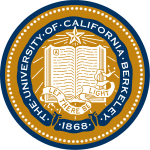 | |
Former names | University of California (1868–1958) |
|---|---|
| Motto | Fiat lux (Latin) |
Motto in English | "Let there be light" |
| Type | Public land-grant research university |
| Established | March 23, 1868[1] |
Parent institution | University of California |
| Accreditation | WSCUC |
Academic affiliations | |
| Endowment | $6.8 billion (2021)[2][3][4][5] |
| Chancellor | Carol T. Christ |
| Provost | Benjamin E. Hermalin[6] |
Total staff | 23,524 (2020)[7] |
| Students | 45,057 (Fall 2021)[8] |
| Undergraduates | 31,814 (Fall 2021)[8] |
| Postgraduates | 13,243 (Fall 2021)[8] |
| Location | , , United States 37°52′19″N 122°15′31″W / 37.8719°N 122.2585°W[9] |
| Campus | Midsize City[10] Core Campus: 178 acres (72 ha)[11] Total: 8,163 acres (3,303 ha)[12] |
| Newspaper | The Daily Californian |
| Colors | Berkeley Blue California Gold[13] |
| Nickname | Golden Bears |
Sporting affiliations | |
| Mascot | Oski the Bear |
| Website | www |
 | |
The University of California, Berkeley (UC Berkeley, Berkeley, Cal, or California)[14][15] is a public land-grant research university in Berkeley, California. Established in 1868 as the University of California, it is the state's first land-grant university and the first campus of the University of California system. Its fourteen colleges and schools offer over 350 degree programs and enroll some 31,800 undergraduate and 13,200 graduate students.[8][16][17] Berkeley has consistently ranked among the world's top universities.[18]
A founding member of the Association of American Universities, Berkeley hosts many leading research institutes dedicated to science, engineering, and mathematics.[19] It founded and maintains close relationships with three national laboratories at Berkeley, Livermore and Los Alamos,[20] and has played a prominent role in many scientific advances, from the Manhattan Project and the discovery of 16 chemical elements to breakthroughs in computer science and genomics.[21] Berkeley is also known for political activism and the Free Speech Movement of the 1960s.[22]
Berkeley's athletic teams, which compete as the California Golden Bears primarily in the Pac-12 Conference, have won 107 national championships, and its students and alumni have won 223 Olympic medals (including 121 gold medals).[23][24]
Among its alumni, faculty and researchers, Berkeley has more Nobel laureates,[25] Turing Award winners (25), Fields Medalists (14), and Wolf Prize winners (30) than any other public university in the nation; it is affiliated with 34 Pulitzer Prizes, 19 Academy Awards, and more MacArthur "Genius Grants" (108) and National Medals of Science (68) than any other public institution. The university has produced seven heads of state or government; six chief justices, including Chief Justice of the United States Earl Warren;[26] 22 cabinet-level officials; 11 governors; and 25 living billionaires.[27] It is also a leading producer of Fulbright Scholars, MacArthur Fellows, and Marshall Scholars.[28] Berkeley alumni, widely recognized for their entrepreneurship, have founded numerous notable companies, including Apple, Tesla, Intel, eBay, SoftBank, AIG, and Morgan Stanley.[29]
History
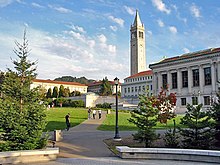
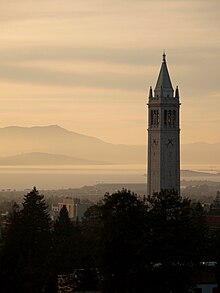
Founding
Made possible by President Lincoln's signing of the Morrill Act in 1862, the University of California was founded in 1868 as the state's first land-grant university, inheriting the land and facilities of the private College of California and the federal-funding eligibility of a public agricultural, mining, and mechanical arts college.[30] The Organic Act states that the "University shall have for its design, to provide instruction and thorough and complete education in all departments of science, literature and art, industrial and professional pursuits, and general education, and also special courses of instruction in preparation for the professions".[31][32]
Ten faculty members and 40 male students made up the fledgling university when it opened in Oakland in 1869.[33] Frederick H. Billings, a trustee of the College of California, suggested that a new campus site north of Oakland be named in honor of Anglo-Irish philosopher George Berkeley.[34] The university began admitting women the following year.[35] In 1870, Henry Durant, founder of the College of California, became its first president. With the completion of North and South Halls in 1873, the university relocated to its Berkeley location with 167 male and 22 female students.[36][37] The first female student to graduate was Rosa L. Scrivener in 1874, admitted in the first class to include women in 1870.[38]
Beginning in 1891, Phoebe Apperson Hearst funded several programs and new buildings and, in 1898, sponsored an international competition in Antwerp, Belgium, where French architect Émile Bénard submitted the winning design for a campus master plan.
20th century
In 1905, the University Farm was established near Sacramento, ultimately becoming the University of California, Davis.[39] In 1919, Los Angeles State Normal School became the southern branch of the university, which ultimately became the University of California, Los Angeles.[40] By the 1920s, the number of campus buildings in Berkeley had grown substantially and included twenty structures designed by architect John Galen Howard.[41]
In 1917, one of the nation's first ROTC programs was established at Berkeley[42] and its School of Military Aeronautics began training pilots, including Gen. Jimmy Doolittle. In 1926, future Fleet Admiral Chester W. Nimitz established the first Naval ROTC unit at Berkeley.[43] Berkeley ROTC alumni include former Secretary of Defense Robert McNamara, Army Chief of Staff Frederick C. Weyand, sixteen other general officers, ten Navy flag officers, and AFROTC alumna Captain Theresa Claiborne.[44]
In the 1930s, Ernest Orlando Lawrence helped establish the Radiation Laboratory (now Lawrence Berkeley National Laboratory) and invented the cyclotron, which won him the Nobel physics prize in 1939.[45] Using the cyclotron, Berkeley professors and Berkeley Lab researchers went on to discover 16 chemical elements—more than any other university in the world.[46][47] In particular, during World War II and following Glenn Seaborg's then-secret discovery of plutonium, Lawrence's Radiation Laboratory began to contract with the U.S. Army to develop the atomic bomb. Physics professor J. Robert Oppenheimer was named scientific head of the Manhattan Project in 1942.[48][49] Along with the Lawrence Berkeley National Laboratory, Berkeley founded and was then a partner in managing two other labs, Los Alamos National Laboratory (1943) and Lawrence Livermore National Laboratory (1952).
In 1952, the University of California reorganized itself into a system of semi-autonomous campuses, with each campus given a chancellor, and Clark Kerr became Berkeley's first Chancellor, while Robert Sproul remained in place as the President of the University of California.[50]
Berkeley gained a worldwide reputation for political activism in the 1960s.[51][52] In 1964, the Free Speech Movement organized student resistance to the university's restrictions on political activities on campus—most conspicuously, student activities related to the Civil Rights Movement. The arrest in Sproul Plaza of Jack Weinberg, a recent Berkeley alumnus and chair of Campus CORE, in October 1964, prompted a series of student-led acts of formal remonstrance and civil disobedience that ultimately gave rise to the Free Speech Movement, which movement would prevail and serve as a precedent for student opposition to America's involvement in the Vietnam War.[53][54][55]
In 1982, the Mathematical Sciences Research Institute (MSRI) was established on campus with support from the National Science Foundation and at the request of three Berkeley mathematicians — Shiing-Shen Chern, Calvin Moore, and Isadore M. Singer. The institute is now widely regarded as a leading center for collaborative mathematical research, drawing thousands of visiting researchers from around the world each year.[56][57][58]
21st century
In the current century, compared to the 1960s and 70s, Berkeley has become less politically active, although more liberal.[59][60] Democrats outnumber Republicans on the faculty by a ratio of nine to one, which is a ratio similar to that of American academia generally.[61]
The school has also become more focused on entrepreneurship and fundraising, especially for STEM disciplines.[62][63] In 2007, the Energy Biosciences Institute was established with funding from BP and Stanley Hall, a research facility and headquarters for the California Institute for Quantitative Biosciences, opened. The next few years saw the dedication of the Center for Biomedical and Health Sciences, funded by a lead gift from billionaire Li Ka-shing; the opening of Sutardja Dai Hall, home of the Center for Information Technology Research in the Interest of Society; and the unveiling of Blum Hall, housing the Blum Center for Developing Economies. Supported by a grant from alumnus James Simons, the Simons Institute for the Theory of Computing was established in 2012. In 2014, Berkeley and its sister campus, UCSF, established the Innovative Genomics Institute, and, in 2020, an anonymous donor pledged $252 million to help fund a new center for computing and data science.[64]
Organization and administration
Although the University of California system does not have an official flagship campus, many scholars and experts consider Berkeley to be its unofficial flagship. In some cases, it shares this unofficial status with the University of California, Los Angeles.[65]
Name
Officially the University of California, Berkeley, its name is often shortened to Berkeley in general reference or in an academic context (www.berkeley.edu, Berkeley Law, Berkeley Engineering, Berkeley Haas, Berkeley Public Health) or to California or Cal, particularly when referring to its athletic teams (California Golden Bears).[14][15][66]
Governance
The University of California is governed by a 26-member Board of Regents, 18 of whom are appointed by the Governor of California to 12-year terms. The board also has seven ex officio members, a student regent, and a non-voting student regent-designate.[67] Prior to 1952, Berkeley was the University of California, so the university president was also Berkeley's chief executive. In 1952, the university reorganized itself into a system of semi-autonomous campuses, with each campus having its own chief executive, a chancellor, who would, in turn, report to the president of the university system. Twelve vice chancellors report directly to Berkeley's chancellor, and the deans of the 14 colleges and schools report to the executive vice chancellor and provost, Berkeley's chief academic officer.[68]
Twenty-five presidents and chancellors have led Berkeley since its founding.[69][50]
|
Presidents
|
|
Chancellors
|
|
Funding
Berkeley receives funding from a variety of federal, state, and private sources. With the exception of government contracts, public support is apportioned to Berkeley and the other campuses of the University of California system through the UC Office of the President and accounts for some 12 percent of Berkeley's total revenues.[70] Berkeley has long benefited from private philanthropy, with considerable gifts from the Flood, Hearst, Durant, Strauss, Lick, Harmon, and Bacon families in the 19th century and from the Hearst, Doe, Sather, Rockefeller, Cowell, Haviland, Bowles, Boalt, and Stern families, among others, in the first half of the 20th century. More recently, alumni and their foundations have given to the university for operations and capital expenditures.[citation needed]
Berkeley has also benefited from the giving of individuals, corporations, and foundations, notable among which are Mark Zuckerberg and Priscilla Chan (pledged $600 million, shared with UCSF and Stanford University, to form the Biohub);[citation needed] BP (pledged $400 million to research biofuels); the Bill and Melinda Gates Foundation (over $68 million since the foundation's creation), billionaire Sir Li Ka-Shing (multiple gifts, most notably a $40 million gift in 2005), Israeli-Russian billionaire Yuri Milner, Thomas and Stacey Siebel, Sanford and Joan Weill, and professor Gordon Rausser ($50 million gift in 2020).[citation needed] Several significant gifts have been made anonymously, including a 1999 gift of $50 million to support molecular engineering, a 2018 gift of $50 million to support STEM faculty,[71] a $70 million gift in 2019 to support the BioEnginuity Hub,[72] and a gift in 2020 of $252 million to support data science.[73]
The 2008–13 Campaign for Berkeley raised $3.13 billion from 281,855 donors, and the "Light the Way" campaign, announced in early 2020, is scheduled to raise $6 billion by the end of 2023.[74]
Academics
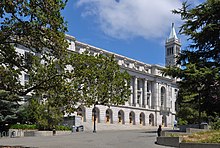

Berkeley is a large, primarily residential Tier One research university with a majority of its enrollment in undergraduate programs but also offering a comprehensive doctoral program.[75] The university has been accredited by the Western Association of Schools and Colleges Senior College and University Commission since 1949.[76] The university operates on a semester calendar and awarded 8,725 bachelor's, 3,286 master's or professional and 1,272 doctoral degrees in 2018–2019.[17]
The university's academic enterprise is organized into 14 colleges and schools, which, in turn, comprise 180 departments and 80 interdisciplinary units offering over 350 degree programs. Colleges serve both undergraduate and graduate students, while schools are generally graduate only, though some offer undergraduate majors or minors.
- College of Chemistry
- College of Engineering
- College of Environmental Design
- College of Letters and Science
- Graduate School of Education
- Graduate School of Journalism
- Haas School of Business
- Goldman School of Public Policy
- Rausser College of Natural Resources
- School of Information
- School of Law
- Wertheim School of Optometry
- School of Public Health
- School of Social Welfare
- UC Berkeley Extension (currently has two locations, in downtown Berkeley and downtown San Francisco).
Undergraduate programs

The four-year, full-time undergraduate program offers 107 bachelor's degrees across the Haas School of Business (1), College of Chemistry (5), College of Engineering (20), College of Environmental Design (4), College of Letters and Science (67), Rausser College of Natural Resources (10), and individual majors (2).[77] The most popular majors are Electrical Engineering and Computer Science, Political Science, Molecular and Cell Biology, Environmental Science, and Economics.[78]
Requirements for undergraduate degrees are set by four authorities: the University of California system, the Berkeley campus, the college or school, and the department. These requirements include an entry-level writing requirement before enrollment (typically fulfilled by minimum scores on standardized admissions exams such as the SAT or ACT), completing coursework on "American History and Institutions" before or after enrollment by taking an introductory class, passing an "American Cultures Breadth" class at Berkeley, as well as requirements for reading and composition and specific requirements declared by the department and school.[79] Three-hour final examinations are required in most undergraduate classes and take place over a week following the last day of instruction in mid-December for the Fall semester and in mid-May for the Spring semester.[80] Academic grades are reported on a four-point, five-letter scale (A thru F) with grade points being modified by three-tenths of point for pluses and minuses, save for the A+, which carries just four points.[81] Requirements for academic honors are specified by individual schools and colleges, scholarly prizes are typically awarded by departments, and students are elected to honor societies based on these organizations' criteria.[82]
Graduate and professional programs

Berkeley has a "comprehensive" graduate program, with high coexistence with the programs offered to undergraduates, and offers interdisciplinary graduate programs with the medical schools at UCSF (various masters and doctoral) and Stanford (MD/MPH). The university offers Master of Arts, Master of Science, Master of Fine Arts, and PhD degrees in addition to professional degrees such as the Juris Doctor, Master of Business Administration, Master of Public Health, and Master of Design.[75][83] The university awarded 963 doctoral degrees and 3,531 master's degrees in 2017.[84] Admission to graduate programs is decentralized; applicants apply directly to the department or degree program. Most graduate students are supported by fellowships, teaching assistantships, or research assistantships.[84]
Faculty and research
Berkeley is classified among "R1: Doctoral Universities—Very high research activity".[75] In fiscal year 2021, Berkeley's funding for research and development exceeded $1 billion.[85] There are 1,629 full-time and 896 part-time faculty members among more than 130 academic departments and more than 80 interdisciplinary research units.[16] The current faculty includes 260 American Academy of Arts and Sciences Fellows, three Fields Medalists, 77 Fulbright Scholars, 139 Guggenheim Fellows, 78 members of the National Academy of Engineering, 149 members of the National Academy of Sciences,[86] eight Nobel Prize winners, four Pulitzer Prize winners, 125 Sloan Fellows, 8 Wolf Prize winners and 1 Pritzker Prize winner.[16][87][88][89]
Library system

Berkeley's 32 libraries together contain more than 13 million volumes and cover over 12 acres (4.9 ha) of land, forming one of the largest library complexes in the world.[90][91] Doe Library serves as the library system's reference, periodical, and administrative center, while most of the main collections reside in the subterranean Gardner Main Stacks and Moffitt Undergraduate Library. The Bancroft Library, which has over 400,000 printed volumes and 70 million manuscripts, pictures, and maps, maintains special collections that document the history of the western part of North America, with an emphasis on California, Mexico and Central America. The Bancroft Library also houses the Mark Twain Papers,[92] the Oral History Center,[93] the Center for the Tebtunis Papyri[94] and the University Archives.[95]
Rankings
Nationally, the 2018–19 Center for World University Rankings (CWUR) ranked the university the top public university in the nation and fourth overall based on quality of education, alumni employment, quality of faculty, publications, influence, and citations.[105] The 2021 Forbes America's Top Colleges report ranked Berkeley #1 among 600 private and public universities and liberal arts colleges in the United States.[106] For 2015 Kiplinger ranked Berkeley the 4th best-value public university in the nation for in-state students, and 6th for out-of-state students.[107] The Money Magazine Best Colleges ranking for 2015 ranked Berkeley 9th in the United States, based on educational quality, affordability and alumni earnings.[108] For 2021, QS "World University Rankings: USA" places Berkeley fourth among all US universities and first among publics.[109] In 2014, The Daily Beast's Best Colleges report ranked Berkeley 11th in the country.[110] The 2013 Top American Research Universities report by the Center for Measuring University Performance ranked Berkeley 8th overall, 5th in resources, faculty, and education, 9th in resources and education, and 1st in education.[111] The 2019–20 U.S. News & World Report's Best Colleges Ranking places Berkeley second among public universities and 22nd among national universities.[112] Washington Monthly ranked Berkeley 10th among national universities in 2021, with criteria based on research, community service, and social mobility. Globally, for 2020–21, the Center for World University Rankings (CWUR) ranked the university 12th in the world based on quality of education, alumni employment, quality of faculty, and research performance.[113] In 2017, the Nature Index ranked the university the ninth largest contributor to papers published in 82 leading journals.[114][115] Past rankingsClark Kerr records: the school's first ranking in 1906 placed it among the top six schools ("Big Six") in the nation. In 1934 it ranked second, tied with Columbia and the University of Chicago, behind only Harvard; in 1957 it was then the only school second to Harvard. In 1964 it was elevated to "best balanced distinguished university", meaning the school had not only the most top departments but also the highest percentage of top ranking departments in its school. The school in 1993 was the only remaining member of the original 1906 "Big Six", along with Harvard; in that year UC Berkeley ranked first and the other five rankings were, starting from second place, Stanford, Harvard, Princeton, MIT, and Yale.[116] The American Council on Education, a private non-profit organization, had ranked Berkeley tenth in 1934. However, by 1942, private funding during the presidency of Sproul rose Berkeley to being ranked second only to Harvard, based on the number of distinguished departments.[50] Times Higher Education in 1990 and later years has considered Berkeley, based on reputation, to be one of the world's "six super brands" along with Oxford, Cambridge, Harvard, MIT, and Stanford.[117][118][119][120][121] Berkeley was the #1 recipient of National Science Foundation Graduate Research Fellowships between 2001 and 2010, with 1,333 awards.[84] The 2010 United States National Research Council Rankings identified Berkeley as having the highest number of top-ranked doctoral programs in the nation. Berkeley doctoral programs that received a #1 ranking included English, German, Political Science, Geography, Agricultural and Resource Economics, Mathematics, Physics, Chemistry, Biochemistry, Molecular Biology, Genetics, Genomics, Epidemiology, Plant Biology, Computer Science, Electrical Engineering, Mechanical Engineering, and Civil and Environmental Engineering.[122] Admissions and enrollment
For Fall 2019, Berkeley's total enrollment was 43,695: 31,780 undergraduate and 11,915 graduate students, with women accounting for 54 percent of undergraduates and 46 percent of graduate and professional students.[17] 6,465 first-time freshmen and 2,554 degree-seeking transfer students matriculated. The acceptance rate for freshmen was 14 percent. Of enrolled freshmen, 55 percent were women. Enrolled freshman had an average unweighted GPA of 3.89 and an average SAT score of 1425. The interquartile range for SAT scores was 1330–1520. Berkeley and other campuses of the University of California do not superscore.[17]
Discoveries and innovation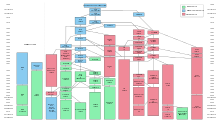 A number of significant inventions and discoveries have been made by Berkeley faculty members and researchers:[21] Natural sciences
Computer and applied sciences
Companies and entrepreneurshipBerkeley alumni and faculty have founded many companies, some of which are shown below.[158][159] Berkeley has often been cited as one of the universities that have produced most entrepreneurs, and boasts its own startup incubator, Berkeley SkyDeck.[159][160][161][162][163]
Campus The Berkeley campus encompasses approximately 1,232 acres (499 ha), though the "central campus" occupies only the low-lying western 178 acres (72 ha) of this area. Of the remaining acres, approximately 200 acres (81 ha) are occupied by the Lawrence Berkeley National Laboratory; other facilities above the main campus include the Lawrence Hall of Science and several research units, notably the Space Sciences Laboratory, the Mathematical Sciences Research Institute, an 800-acre (320 ha) ecological preserve, the University of California Botanical Garden and a recreation center in Strawberry Canyon. Portions of the mostly undeveloped, eastern area of the campus are actually within the City of Oakland; these portions extend from the Claremont Resort north through the Panoramic Hill neighborhood to Tilden Park.[166] 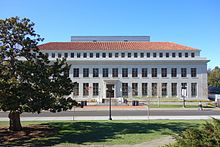 To the west of the central campus is the downtown business district of Berkeley; to the northwest is the neighborhood of North Berkeley, including the so-called Gourmet Ghetto, a commercial district known for high quality dining due to the presence of such world-renowned restaurants as Chez Panisse. Immediately to the north is a quiet residential neighborhood known as Northside with a large graduate student population;[167] situated north of that are the upscale residential neighborhoods of the Berkeley Hills. Immediately southeast of campus lies fraternity row and beyond that the Clark Kerr Campus and an upscale residential area named Claremont. The area south of the university includes student housing and Telegraph Avenue, one of Berkeley's main shopping districts with stores, street vendors and restaurants catering to college students and tourists. In addition, the university also owns land to the northwest of the main campus, a 90-acre (36 ha) married student housing complex in the nearby town of Albany ("Albany Village" and the "Gill Tract"), and a field research station several miles to the north in Richmond, California.  The campus is home to several museums including the University of California Museum of Paleontology, the Berkeley Art Museum and Pacific Film Archive, and the Lawrence Hall of Science. The Museum of Paleontology, found in the lobby of the Valley Life Sciences Building, showcases a variety of dinosaur fossils including a complete cast of a Tyrannosaurus Rex. The campus also offers resources for innovation and entrepreneurship, such as the Big Ideas Competition (Blum Center for Developing Economies), SkyDeck, the Sutardja Center for Entrepreneurship and Technology, and the Berkeley Haas Innovation Lab.[168] The campus is also home to the University of California Botanical Garden, one of the most diverse plant collections in the United States, famous for its large number of rare and endangered species, with more than 12,000 individual species. Outside of the Bay Area, the university owns various research laboratories and research forests in both northern and southern Sierra Nevada. Architecture What is considered the historic campus today was the result of the 1898 "International Competition for the Phoebe Hearst Architectural Plan for the University of California", funded by William Randolph Hearst's mother and initially held in the Belgian city of Antwerp; eleven finalists were judged again in San Francisco in 1899.[169] The winner was Frenchman Émile Bénard, who refused to personally supervise the implementation of his plan and the task was subsequently given to architecture professor John Galen Howard. Howard designed over twenty buildings, which set the tone for the campus up until its expansion in the 1950s and 1960s. The structures forming the "classical core" of the campus were built in the Beaux-Arts Classical style, and include Hearst Greek Theatre, Hearst Memorial Mining Building, Doe Memorial Library, California Hall, Wheeler Hall, (Old) Le Conte Hall, Gilman Hall, Haviland Hall, Wellman Hall, Sather Gate, and the 307-foot (94 m) Sather Tower (nicknamed "the Campanile" after its architectural inspiration, St Mark's Campanile in Venice), the tallest university clock tower in the United States.[170] Buildings he regarded as temporary, nonacademic, or not particularly "serious" were designed in shingle or Collegiate Gothic styles; examples of these are North Gate Hall, Dwinelle Annex, and Stephens Hall. Many of Howard's designs are recognized California Historical Landmarks[171] and are listed on the National Register of Historic Places. Built in 1873 in a Victorian Second-Empire-style, South Hall, designed by David Farquharson, is the oldest university building in California. It, and the Frederick Law Olmsted-designed Piedmont Avenue east of the main campus, are two of the only surviving examples of the nineteenth-century campus. Other notable architects and firms whose work can be found in the campus and surrounding area are Bernard Maybeck[172] (Faculty Club); Julia Morgan (Hearst Women's Gymnasium and Julia Morgan Hall); William Wurster (Stern Hall); Moore Ruble Yudell (Haas School of Business); Tod Williams Billie Tsien Architects (C.V. Starr East Asian Library), and Diller Scofidio + Renfro (Berkeley Art Museum and Pacific Film Archive). Natural features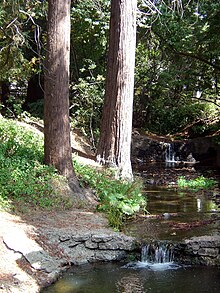 Flowing into the main campus are two branches of Strawberry Creek. The south fork enters a culvert upstream of the recreational complex at the mouth of Strawberry Canyon and passes beneath California Memorial Stadium before appearing again in Faculty Glade. It then runs through the center of the campus before disappearing underground at the west end of campus. The north fork appears just east of University House and runs through the glade north of the Valley Life Sciences Building, the original site of the Campus Arboretum. Trees in the area date from the founding of the university. The campus features numerous wooded areas, including: Founders' Rock, Faculty Glade, Grinnell Natural Area, and the Eucalyptus Grove, which is both the tallest stand of such trees in the world and the tallest stand of hardwood trees in North America.[173] The campus sits on the Hayward Fault, which runs directly through California Memorial Stadium.[174] Student life and traditions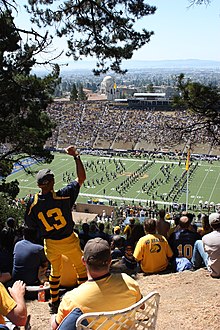 The official university mascot is Oski the Bear, who debuted in 1941. Previously, live bear cubs were used as mascots at Memorial Stadium until it was decided in 1940 that a costumed mascot would be a better alternative. Named after the Oski-wow-wow yell, he is cared for by the Oski Committee, whose members have exclusive knowledge of the identity of the costume-wearer.[175] The University of California Marching Band, which has served the university since 1891, performs at every home football game and at select road games as well. A smaller subset of the Cal Band, the Straw Hat Band, performs at basketball games, volleyball games, and other campus and community events.[176] The UC Rally Committee, formed in 1901, is the official guardian of California's Spirit and Traditions. Wearing their traditional blue and gold rugbies, Rally Committee members can be seen at all major sporting and spirit events. Committee members are charged with the maintenance of the six Cal flags, the large California banner overhanging the Memorial Stadium Student Section and Haas Pavilion, the California Victory Cannon, Card Stunts and The Big "C" among other duties. The Rally Committee is also responsible for safekeeping of the Stanford Axe when it is in Cal's possession.[177] The Chairman of the Rally Committee holds the title "Custodian of the Axe" while it is in the committee's care. Overlooking the main Berkeley campus from the foothills in the east, The Big "C" is an important symbol of California school spirit. The Big "C" has its roots in an early 20th-century campus event called "Rush", which pitted the freshman and sophomore classes against each other in a race up Charter Hill that often developed into a wrestling match. It was eventually decided to discontinue Rush and, in 1905, the freshman and sophomore classes banded together in a show of unity to build "the Big C".[178] Owing to its prominent position, the Big "C" is often the target of pranks by rival Stanford University students who paint the Big "C" red and also fraternities and sororities who paint it their organization's colors. One of the Rally Committee's functions is to repaint the Big "C" to its traditional color of King Alfred Yellow. Cal students invented the college football tradition of card stunts. Then known as Bleacher Stunts, they were first performed during the 1910 Big Game and consisted of two stunts: a picture of the Stanford Axe and a large blue "C" on a white background. The tradition is continued today by the Rally Committee in the Cal student section and incorporates complicated motions, for example tracing the Cal script logo on a blue background with an imaginary yellow pen.[179] The California Victory Cannon, placed on Tightwad Hill overlooking the stadium, is fired before every football home game, after every score, and after every Cal victory. First used in the 1963 Big Game, it was originally placed on the sidelines before moving to Tightwad Hill in 1971. The only time the cannon ran out of ammunition was during a game against Pacific in 1991, when Cal scored 12 touchdowns.[180] The Cal Mic Men, a standard at home football games, has recently expanded to involve basketball and volleyball. The traditional role comes from students holding megaphones and yelling, but now includes microphones, a dedicated platform during games, and the direction of the entire student section.[181] Both men and women are allowed to fulfill the role, despite the name. Student housingBerkeley students are offered a variety of housing options, including university-owned or affiliated residences, private residences, fraternities and sororities, and cooperative housing (co-ops). University housing The university runs twelve different residence halls: seven undergraduate residence halls or complexes, both with and without themes; family student housing; re-entry student housing; and optional international student housing at the International House, built with a gift from John D. Rockefeller, Jr. and the erstwhile home of six Nobel laureates. Undergraduate residence halls are located off-campus in the city of Berkeley. Units 1, 2 and 3, located on the south side of campus, offer high-rise accommodations with common areas on every other floor. Units 1 and 2 share a common dining hall, Crossroads. The oldest unit, Unit 3, has its own dining hall, Café 3, on the first floor.[182] At the beginning of the 2018–2019 school year, a new building called Blackwell Hall, was opened across the street from Unit 3. These buildings share a dining hall. Further away and also on the south side of campus is Clark Kerr, an undergraduate residential complex that houses many student athletes and was once a school for the deaf and blind. In the foothills east of the central campus, there are three additional undergraduate residence halls: Foothill, Stern, and Bowles. Foothill is a co-ed, suite-style hall reminiscent of a Swiss chalet. Just south of Foothill, overlooking the Hearst Greek Theatre, is the all-women's traditional-style Stern Hall, which boasts an original mural by Diego Rivera. Because of their proximity to the College of Engineering and College of Chemistry, these residence halls often house science and engineering majors. They tend to be quieter than the southside complexes but often get free glimpses of concerts owing to their proximity to the theater.  Bowles Hall, the country's oldest residential college, is located on the north side of campus between California Memorial Stadium and the Hearst Greek Theater. Gifted by Mary McNear Bowles in 1929 to honor her late husband, Regent Philip E. Bowles, the college began as a student-governed residence hall.[183] The hall was originally all male until its reopening in 2016 following a $45 million renovation.[184] Bowles is known for its Collegiate Gothic architecture, its sense of community, and its unusual traditions and pranks.[185] The Channing-Bowditch and Ida Jackson apartments cater to re-entry students,[186][187] while the 58-acre University Village, located some 3 miles (4.8 km) northwest of campus, provides housing for students with families. Cooperative housingBerkeley students, and those of other local schools, have the option of living in one of the twenty cooperative houses participating in the Berkeley Student Cooperative (BSC), a nonprofit housing cooperative network consisting of 20 residences and 1250 member-owners.[188] Notable BCS alumni include Norman Mineta, Steve Wozniak, Gordon Moore, Nathan Huggins, Marion Nestle, and Beverly Cleary. Fraternities and sororitiesAbout three percent of undergraduate men and nine percent of undergraduate women—or 3,400 of total undergraduates—are active in Berkeley's Greek system.[189] University-sanctioned fraternities and sororities comprise over 60 houses affiliated with four Greek councils.[190][191]
Student-run organizationsAssociated Students of the University of California (ASUC)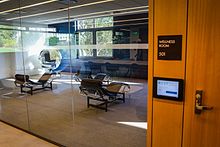 The Associated Students of the University of California (ASUC) is the official student association that controls funding for student groups and organizes on-campus student events. It is considered[by whom?] the most autonomous student government at any university in the U.S. due to its independent funding model, level of university involvement and resources.[citation needed] The two main political parties are "Student Action"[193] and "CalSERVE".[194] The organization was founded in 1887 and has an annual operating budget of $1.7 million (excluding the budget of the Graduate Assembly of the ASUC), in addition to various investment assets. Its alumni include multiple State Senators, Assemblymembers, and White House Administration officials.[195][circular reference] The ASUC's Student Union Program, Entertainment, and Recreation Board (SUPERB) is a student-run, non-profit branch dedicated to providing entertainment for the campus and community. Founded in 1964, SUPERB's programming includes the Friday Film Series, free Noon Concerts on Lower Sproul Plaza, Comedy Competitions, Poker Tournaments, free Sneak Previews of upcoming movies, and more. Media and publicationsBerkeley's student-run online television station, CalTV, was formed in 2005 and broadcasts online. It is run by students with a variety of backgrounds and majors. Since the mid-2010s, it has been a program of the ASUC.[196] Berkeley's independent student-run newspaper is The Daily Californian. Founded in 1871, The Daily Cal became independent in 1971 after the campus administration fired three senior editors for encouraging readers to take back People's Park. The Daily Californian has both a print and online edition. Print circulation is about 10,000. The newspaper is an important source of information for students, faculty, staff, and the surrounding City of Berkeley. Berkeley's FM Student radio station, KALX, broadcasts on 90.7 MHz. It is run largely by volunteers, including both students and community members. Berkeley also features an assortment of student-run publications:
Student groups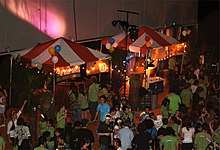 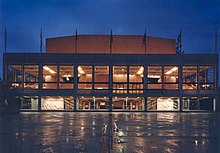 There are some 94 political student groups on campus, including MEChXA de UC Berkeley, Berkeley ACLU, Berkeley Students for Life, Campus Greens, The Sustainability Team (STEAM), the Berkeley Student Food Collective, Students for Sensible Drug Policy, Cal Berkeley Democrats, and the Berkeley College Republicans.[197] The Residence Hall Assembly (RHA) is the student-led umbrella organization that oversees event planning, legislation, sponsorships and other activities for over 7,2000 on-campus undergraduate residents.[198] Berkeley students also run a number of consulting groups, including the Berkeley Group, founded in 2003 and affiliated with the Haas School.[199] Students from various concentrations are recruited and trained to work on pro-bono consulting engagements with actual nonprofit clients. Berkeley Consulting, founded in 1996, has served over 140 companies across the high-tech, retail, banking, and non-profit sectors.[200] ImagiCal[201] has been the college chapter of the American Advertising Federation at Berkeley since the late 1980s. The team competes annually in the National Student Advertising Competition, with students from disparate majors working together on a marketing case underwritten by a corporate sponsor. The Berkeley Forum is a nonpartisan student organization that hosts panels, debates, and speeches across a variety of fields.[202] Past speakers include Senator Rand Paul, entrepreneur and venture capitalist Peter Thiel, and Khan Academy founder Salman Khan. 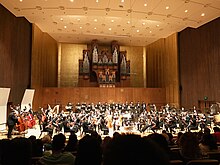 Democratic Education at Cal, or DeCal, is a program that promotes the creation of professor-sponsored, student-facilitated classes.[203] DeCal arose out of the 1960s Free Speech movement and was officially established in 1981. The program offers around 150 courses on a vast range of subjects that appeal to the student community, including classes on the Rubik's Cube, blockchain, web design, metamodernism, cooking, Jewish art, 3D animation, and bioprinting.[204] The campus is home to several a cappella groups, including Drawn to Scale, Artists in Resonance, Berkeley Dil Se, the UC Men's Octet, the California Golden Overtones, and Noteworthy. The University of California Men's Octet was founded in 1948 and features a repertoire of barbershop, doo-wop, contemporary pop, modern alternative, and fight songs. Hewing to tradition, the groups perform weekly under Sather Gate on alternating days. Berkeley hosts a myriad other performing arts groups in comedy, dance, acting and instrumental music, and include jericho!, Improv & Sketch Comedy, The Movement, Taiko drumming, BareStage student musical theater, the Remedy Music Project, Main Stacks, AFX Dance, and TruElement. Since 1967, students and staff jazz musicians have had an opportunity to perform and study with the University of California Jazz Ensembles. Under the direction of Dr. David W. Tucker, who was hired by the Cal Band as a composer, arranger, and associate director, but was later asked to direct the jazz ensembles as it grew in popularity and membership, the group grew rapidly from one big band to multiple big bands, numerous combos, and numerous instrumental classes with multiple instructors. For several decades it hosted the Pacific Coast Collegiate Jazz Festival, part of the American Collegiate Jazz Festival, a competitive forum for student musicians. PCCJF brought jazz artists including Hubert Laws, Sonny Rollins, Freddie Hubbard, and Ed Shaughnessy to the Berkeley campus as performers, clinicians, and adjudicators. The festival later included high school musicians. Michael Wolff and Andy Narell are just a couple of its more famous alumni. Berkeley student organizations also hosts many other conferences, seminars, and musical and theatrical performances, including the annual Sociological Research Symposium. Engineering Student TeamsGiven UC Berkeley's STEM education and its proximity to Silicon Valley, there are a variety of student-run engineering teams that focus on winning design and engineering competitions. Berkeley has two prominent amateur rocketry teams: Space Enterprise at Berkeley (SEB)[205] and Space Technologies and Rocketry (STAR).[206] Both have launched solid-fuel sounding rockets and are currently developing liquid propellant rockets. The university also has two Formula SAE teams: Berkeley Formula Racing[207] and Formula Electric Berkeley.[208] Both of these teams participate in Formula SAE–run competitions, with the former focusing on internal combustion engines and the latter on electric motors. Berkeley has a number of other vehicle teams, including CalSol,[209] CalSMV,[210] and Human Powered Vehicle.[211] Athletics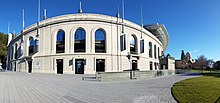 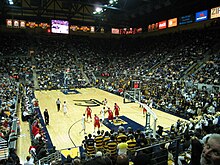  The university's athletic teams are known as the California Golden Bears (often shortened to "Cal Bears" or just "Cal") and are primarily members of the NCAA Division I Pac-12 Conference (Pac-12). Cal is also a member of the Mountain Pacific Sports Federation in several sports not sponsored by the Pac-12 and the America East Conference in women's field hockey. The first school colors, established in 1873 by a committee of students, were blue (specifically Yale Blue) and gold.[212][213] Yale Blue was originally chosen because many of the university's inaugural faculty were Yale graduates, including Henry Durant, its first president. Blue and gold were specified and made the official colors of the university and the state colors of California in 1955.[212][214] In 2014, the athletic department specified a darker blue.[215][216] The California Golden Bears have won national titles in football, men's basketball, baseball, softball, men's and women's crew, men's gymnastics, men's tennis, men's and women's swimming, men's water polo, men's Judo, men's track, and men's rugby. In addition, Cal athletes have won individual NCAA titles in track, gymnastics, swimming and tennis. On January 31, 2009, the university's Hurling club made athletic history by defeating Stanford in the first collegiate hurling match ever played on American soil. Berkeley teams have won national championships in baseball (2), men's basketball (2), men's crew (15), women's crew (3), football (5), men's golf (1), men's gymnastics (4), men's lacrosse (1), men's rugby (26), softball (1), men's swimming & diving (4), women's swimming & diving (3), men's tennis (1), men's track & field (1), and men's water polo (13).  Cal students and alumni have also won 207 Olympic medals.[218] California finished in first place[219] in the 2007–08 Fall U.S. Sports Academy Directors' Cup standings (Now the NACDA Directors' Cup), a competition measuring the best overall collegiate athletic programs in the country, with points awarded for national finishes in NCAA sports. Cal finished the 2007–08 competition in seventh place with 1119 points.[220] Most recently, California finished in third place in the 2010–11 NACDA Directors' Cup with 1219.50 points, finishing behind Stanford and Ohio State. This is California's highest ever finish in the Director's Cup.[221] The Golden Bears' traditional arch-rival is the Stanford Cardinal, and the most anticipated sporting event between the two universities is the annual football match dubbed the Big Game, celebrated with spirit events on both campuses. Since 1933, the winner of the Big Game has been awarded custody of the Stanford Axe. Other sporting games between these rivals have related names such as the Big Splash (water polo) or the Big Kick (soccer).[222] One of the most famous moments in college football history occurred during the 85th Big Game on November 20, 1982. In what has become known as "the band play" or simply The Play, Cal scored the winning touchdown in the final seconds with a kickoff return that involved a series of laterals and the Stanford marching band rushing onto the field. Notable alumni, faculty, and staffBerkeley alumni, faculty and staff have distinguished themselves in a wide range of endeavors and include 114 Nobel laureates (35 alumni), 25 Turing Award winners (11 alumni), 14 Fields Medalists, 30 Wolf Prize winners, 108 MacArthur Fellows (65 alumni) , 30 Pulitzer Prize recipients, 19 Academy Award winners, five foreign heads of state, chief justices of the United States and California,[223] 22 cabinet members, ten state governors, numerous members of Congress, 36 general and flag officers of the United States Armed Forces, 40 billionaires, and the founders or co-founders of many world-renowned companies.
Faculty and staff
AlumniBerkeley alumni have served in a range of prominent government offices, both domestic and foreign, including Chief Justice of the United States Supreme Court (Earl Warren, BA, JD); United States Attorney General (Edwin Meese III, JD); United States Secretary of State (Dean Rusk, LLB); United States Secretary of the Treasury (W. Michael Blumenthal, BA, and G. William Miller, JD); United States Secretary of Defense (Robert McNamara, BS); United States Secretary of the Interior (Franklin Knight Lane, 1887); United States Secretary of Transportation and United States Secretary of Commerce (Norman Mineta, BS); United States Secretary of Agriculture (Ann Veneman, MPP); National Security Advisor (Robert C. O'Brien, JD); scores of federal judges and members of the United States Congress (10 currently serving) and United States Foreign Service; governors of California (George C. Pardee; Hiram W. Johnson; Earl Warren, BA and LLB; Jerry Brown, BA; and Pete Wilson, JD), Michigan (Jennifer Granholm, BA), and the United States Virgin Islands (Walter A. Gordon, BA); Chief of Staff of the United States Army (Frederick C. Weyand, Class of 1938); Lieutenant General of the United States Army (Jimmy Doolittle); Vice Admiral of the United States Navy (Murry L. Royar, Class of 1916); Major General of the United States Marine Corps (Oliver Prince Smith); Brigadier General of the United States Marine Corps (Bertram A. Bone); Director of the Central Intelligence Agency and Chairman of the Atomic Energy Commission (John A. McCone, BS); chair and members of the Council of Economic Advisors (Michael Boskin, BA, PhD.; Sandra Black, BA; Jesse Rothstein, PhD; Robert Seamans, PhD; Jay Shambaugh, PhD; James Stock, MA, PhD); Governor of the Federal Reserve System (H. Robert Heller, PhD) and President and CEO of the Federal Reserve Bank of New York (William Dudley, PhD); Commissioners of the SEC (Troy A. Paredes, BA) and the FCC (Rachelle Chong, BA); and United States Surgeon General (Kenneth P. Moritsugu, MPH). Foreign alumni include the President of Colombia 1922–1926, (Pedro Nel Ospina Vázquez, BA, Mining Engineering); the President of Mexico (Francisco I. Madero, attended 1892–93); the President and Prime Minister of Pakistan; the Premier of the Republic of China (Sun Fo, BA); the President of Costa Rica (Miguel Angel Rodriguez, MA, PhD); and members of parliament of the United Kingdom (House of Lords, Lydia Dunn, Baroness Dunn, BS), India (Rajya Sabha, the upper house, Prithviraj Chavan, MS); Iran (Mohammad Javad Larijani, PhD); Nigerian Minister of Science and Technology and first Executive Governor of Abia State (Ogbonnaya Onu, PhD Chemical Engineering); Barbados' Ambassador to Brazil (Tonika Sealy-Thompson). Alumni have also served in many supranational posts, notable among which are President of the World Bank (Robert McNamara, BS); Deputy Prime Minister of Spain and managing director of the International Monetary Fund (Rodrigo Rato, MBA); executive director of UNICEF (Ann Veneman, MPP); member of the European Parliament (Bruno Megret, MS); and judge of the World Court (Joan Donoghue, JD). Alumni have made important contributions to science. Some have concentrated their studies on the very small universe of atoms and molecules. Nobel laureate William F. Giauque (BS 1920, PhD 1922) investigated chemical thermodynamics, Nobel laureate Willard Libby (BS 1931, PhD 1933) pioneered radiocarbon dating, Nobel laureate Willis Lamb (BS 1934, PhD 1938) examined the hydrogen spectrum, Nobel laureate Hamilton O. Smith (BA 1952) applied restriction enzymes to molecular genetics, Nobel laureate Robert Laughlin (BA math 1972) explored the fractional quantum Hall effect, and Nobel laureate Andrew Fire (BA math 1978) helped to discover RNA interference-gene silencing by double-stranded RNA. Nobel laureate Glenn T. Seaborg (PhD 1937) collaborated with Albert Ghiorso (BS 1913) to discover 12 chemical elements, such as americium, berkelium, and californium. David Bohm (PhD 1943) discovered Bohm Diffusion. Nobel laureate Yuan T. Lee (PhD 1965) developed the crossed molecular beam technique for studying chemical reactions. Carol Greider (PhD 1987), professor of molecular biology and genetics at Johns Hopkins University School of Medicine, was awarded the 2009 Nobel Prize in medicine for discovering a key mechanism in the genetic operations of cells, an insight that has inspired new lines of research into cancer. Harvey Itano (BS 1942) conducted breakthrough work on sickle cell anemia that marked the first time a disease was linked to a molecular origin.[239] While he was valedictorian of Berkeley's class of 1942, he was unable to attend commencement exercises due to internment.[239] Narendra Karmarkar (PhD 1983) is known for the interior point method, a polynomial algorithm for linear programming known as Karmarkar's algorithm.[240] National Medal of Science laureate Chien-Shiung Wu (PhD 1940), often known as the "Chinese Madame Curie", disproved the Law of Conservation of Parity for which she was awarded the inaugural Wolf Prize in Physics.[241] Kary Mullis (PhD 1973) was awarded the 1993 Nobel Prize in Chemistry for his role in developing the polymerase chain reaction,[242] a method for amplifying DNA sequences. Daniel Kahneman was awarded the 2002 Nobel Memorial Prize in Economics for his work in Prospect theory. Richard O. Buckius, engineer, Bachelor's in Mechanical Engineering '72, Masters '73, PhD '75, currently Chief Operating Officer of the National Science Foundation. Edward P. Tryon (PhD 1967) is the physicist who first said our universe originated from a quantum fluctuation of the vacuum.[243][244][245] John N. Bahcall (BS 1956) worked on the Standard Solar Model and the Hubble Space Telescope,[246] resulting in a National Medal of Science.[246] Peter Smith (BS 1969) was the principal investigator and project leader for the NASA robotic explorer Phoenix,[247] which physically confirmed the presence of water on the planet Mars for the first time.[248] Astronauts James van Hoften (BS 1966), Margaret Rhea Seddon (BA 1970), Leroy Chiao (BS 1983), and Rex Walheim (BS 1984) have orbited the Earth in NASA's fleet of Space Shuttles. Undergraduate alumni have founded or cofounded such companies as Apple Computer,[249] Intel,[250] LSI Logic[251] The Gap,[252] MySpace,[253] PowerBar,[254] Berkeley Systems,[255] Bolt, Beranek and Newman[256] (which created a number of underlying technologies that govern the Internet), Chez Panisse,[257] GrandCentral (known now as Google Voice),[258] HTC Corporation,[259] VIA Technologies,[259] Marvell Technology Group,[260] MoveOn.org,[255] Opsware,[261] RedOctane,[262] Rimon Law P.C.,[263] SanDisk,[264] Scharffen Berger Chocolate Maker,[265] VMware[266] and Zilog,[267] while graduate school alumni have cofounded companies such as DHL,[268] KeyHole Inc (known now as Google Earth),[269] Sun Microsystems,[270] and The Learning Company.[271] Berkeley alumni have also led various technology companies such as Electronic Arts,[272] Google,[273] Adobe Systems,[274] Softbank (Masayoshi Son) and Qualcomm.[275] Berkeley alumni have developed a number of key technologies associated with the personal computer and the Internet.[276] Unix was created by alumnus Ken Thompson (BS 1965, MS 1966) along with colleague Dennis Ritchie. Alumni such as L. Peter Deutsch[277][278][279] (PhD 1973), Butler Lampson (PhD 1967), and Charles P. Thacker (BS 1967)[280] worked with Ken Thompson on Project Genie and then formed the ill-fated US Department of Defense-funded Berkeley Computer Corporation (BCC), which was scattered throughout the Berkeley campus in non-descript offices to avoid anti-war protestors.[281] After BCC failed, Deutsch, Lampson, and Thacker joined Xerox PARC, where they developed a number of pioneering computer technologies, culminating in the Xerox Alto that inspired the Apple Macintosh. In particular, the Alto used a computer mouse, which had been invented by Doug Engelbart (BEng 1952, PhD 1955). Thompson, Lampson, Engelbart, and Thacker[282] all later received a Turing Award. Also at Xerox PARC was Ronald V. Schmidt (BS 1966, MS 1968, PhD 1971), who became known as "the man who brought Ethernet to the masses".[283] Another Xerox PARC researcher, Charles Simonyi (BS 1972), pioneered the first WYSIWIG word processor program and was recruited personally by Bill Gates to join the fledgling company known as Microsoft to create Microsoft Word. Simonyi later became the first repeat space tourist, blasting off on Russian Soyuz rockets to work at the International Space Station orbiting the earth. In 1977, a graduate student in the computer science department named Bill Joy (MS 1982) assembled[284] the original Berkeley Software Distribution, commonly known as BSD Unix. Joy, who went on to co-found Sun Microsystems, also developed the original version of the terminal console editor vi, while Ken Arnold (BA 1985) created Curses, a terminal control library for Unix-like systems that enables the construction of text user interface (TUI) applications. Working alongside Joy at Berkeley were undergraduates William Jolitz (BS 1997) and his future wife Lynne Jolitz (BA 1989), who together created 386BSD, a version of BSD Unix that runs on Intel CPUs and evolved into the BSD family of free operating systems and the Darwin operating system underlying Apple Mac OS X.[285] Eric Allman (BS 1977, MS 1980) created SendMail, a Unix mail transfer agent that delivers about 12 percent of the email in the world.[286] The XCF, an undergraduate research group located in Soda Hall, has been responsible for a number of notable software projects, including GTK+ (created by Peter Mattis, BS 1997), The GIMP (Spencer Kimball, BS 1996), and the initial diagnosis of the Morris worm.[287] In 1992, Pei-Yuan Wei,[288] an undergraduate at the XCF, created ViolaWWW, one of the first graphical web browsers. ViolaWWW was the first browser to have embedded scriptable objects, stylesheets, and tables. In the spirit of Open Source, he donated the code to Sun Microsystems, inspiring Java applets( Kim Polese (BS 1984) was the original product manager for Java at Sun Microsystems.) ViolaWWW also inspired researchers at the National Center for Supercomputing Applications to create the Mosaic web browser,[289] a pioneering web browser that became Microsoft Internet Explorer. Alumni collectively have won at least twenty-five Pulitzer Prizes. Pulitzer Prize–winning journalist Marguerite Higgins (BA 1941) was a pioneering female war correspondent[290][291] who covered World War II, the Korean War, and the Vietnam War.[292] Novelist Robert Penn Warren (MA 1927) won three Pulitzer Prizes,[293] including one for his novel All the King's Men, which was later made into an Academy Award-winning[294] movie. Pulitzer Prize–winning cartoonist Rube Goldberg (BS 1904) invented the comically complex—yet ultimately trivial—contraptions known as Rube Goldberg machines. Journalist Alexandra Berzon (MA 2006) won a Pulitzer Prize in 2009,[295] and journalist Matt Richtel (BA 1989), who also coauthors the comic strip Rudy Park under the pen name of "Theron Heir",[296] won the 2010 Pulitzer Prize for National Reporting.[297] Pulitzer Prize–winning historian Leon Litwack (BA[298] 1951, PhD 1958) taught as a professor at UC Berkeley for 43 years;[299] three other UC Berkeley professors have also received the Pulitzer Prize. Alumna and professor Susan Rasky won the Polk Award for journalism in 1991. USC Professor and Berkeley alumnus Viet Thanh Nguyen's (PhD 1997) first novel The Sympathizer won the 2016 Pulitzer Prize for Fiction[300] Alumni have also written novels and screenplays that have attracted Oscar-caliber talent, including The Call of the Wild author Jack London. Irving Stone (BA 1923) wrote the novel Lust for Life, which was later made into an Academy Award-winning film of the same name starring Kirk Douglas as Vincent van Gogh. Stone also wrote The Agony and the Ecstasy, which was later made into a film of the same name starring Oscar winner Charlton Heston as Michelangelo. Mona Simpson (BA 1979) wrote the novel Anywhere But Here, which was later made into a film of the same name starring Oscar-winning actress Susan Sarandon. Terry McMillan (BA 1986) wrote How Stella Got Her Groove Back, which was later made into a film of the same name starring Oscar-nominated actress Angela Bassett. Randi Mayem Singer (BA 1979) wrote the screenplay for Mrs. Doubtfire, which starred Oscar-winning actor Robin Williams and Oscar-winning actress Sally Field. Audrey Wells (BA 1981) wrote the screenplay The Truth About Cats & Dogs, which starred Oscar-nominated actress Uma Thurman. James Schamus (BA 1982, MA 1987, PhD 2003) has collaborated on screenplays with Oscar-winning director Ang Lee on the Academy Award-winning movies Crouching Tiger, Hidden Dragon and Brokeback Mountain. Collectively, alumni have won at least 20 Academy Awards. Gregory Peck (BA 1939), nominated for four Oscars during his career, won an Oscar for acting in To Kill a Mockingbird. Chris Innis (BA 1991) won the 2010 Oscar for film editing for her work on best picture winner, The Hurt Locker. Walter Plunkett (BA 1923) won an Oscar for costume design (for An American in Paris). Freida Lee Mock (BA 1961) and Charles H. Ferguson (BA 1978) have each[301][302] won an Oscar for documentary filmmaking. Mark Berger (BA 1964) has won four Oscars for sound mixing and is an adjunct professor at UC Berkeley.[303] Edith Head (BA 1918), who was nominated for 34 Oscars during her career, won eight Oscars for costume design. Joe Letteri (BA 1981[304]) has won four Oscars for Best Visual Effects in the James Cameron film Avatar and the Peter Jackson films King Kong, The Two Towers, and The Return of the King.[305] Alumni have collectively won at least 25 Emmy Awards: Jon Else (BA 1968) for cinematography; Andrew Schneider (BA 1973) for screenwriting; Linda Schacht (BA 1966, MA 1981), two for broadcast journalism;[306][307] Christine Chen (dual BA's 1990), two for broadcast journalism;[308] Kristen Sze (BA), two for broadcast journalism;[309] Kathy Baker (BA 1977), three for acting; Ken Milnes (BS 1977), four for broadcasting technology; and Leroy Sievers (BA),[310] twelve for production. Elisabeth Leamy is the recipient of 13 Emmy awards.[311][312][313] Alumni have acted in classic television series that are still broadcast on TV today. Karen Grassle (BA 1965) played the mother Caroline Ingalls in Little House on the Prairie, Jerry Mathers (BA 1974) starred in Leave it to Beaver, and Roxann Dawson (BA 1980) portrayed B'Elanna Torres on Star Trek: Voyager. Former undergraduates have participated in the contemporary music industry, such as Grateful Dead bass guitarist Phil Lesh, The Police drummer Stewart Copeland,[314] Rolling Stone Magazine founder Jann Wenner, The Bangles lead singer Susanna Hoffs (BA 1980), Counting Crows lead singer Adam Duritz, electronic music producer Giraffage, MTV correspondent Suchin Pak (BA 1997),[315] AFI musicians Davey Havok and Jade Puget (BA 1996), and solo artist Marié Digby (Say It Again). People Magazine included Third Eye Blind lead singer and songwriter Stephan Jenkins (BA 1987) in the magazine's list of 50 Most Beautiful People.[316] Alumni have also participated in the world of sports. Tennis athlete Helen Wills Moody (BA 1925) won 31 Grand Slam titles, including eight singles titles at Wimbledon. Tarik Glenn (BA 1999) is a Super Bowl XLI champion, and Mitchell Schwartz (2011) is an All-Pro NFL offensive tackle. Michele Tafoya (BA 1988) is a sports television reporter for ABC Sports and ESPN.[317] Sports agent Leigh Steinberg ( BA 1970, JD 1973) has represented professional athletes such as Steve Young, Troy Aikman, and Oscar De La Hoya; Steinberg has been called the real-life inspiration[318] for the title character in the Oscar-winning[319] film Jerry Maguire (portrayed by Tom Cruise). Matt Biondi (BA 1988) won eight Olympic gold medals during his swimming career, in which he participated in three different Olympics. At the Beijing Olympics in 2008, Natalie Coughlin (BA 2005) became the first American female athlete in modern Olympic history[320] to win six medals in one Olympics. Berkeley alumni—often generous benefactors—have long been among the billionaire ranks, their largess giving rise to many of the campus' eponymous schools, pavilions, centers, institutes, and halls, and with some of the more prominent being J. Paul Getty, Ann Getty, Sanford Diller and Helen Diller, Donald Fisher, Flora Lamson Hewlett, David Schwartz (Bio-Rad) and members of the Haas (Walter A. Haas, Rhoda Haas Goldman, Walter A. Haas Jr., Peter E. Haas, Bob Haas), Hearst, and Bechtel families. There are at least 30 living alumni billionaires: Gordon Moore (Intel founder), James Harris Simons (Renaissance Technologies), Masayoshi Son (SoftBank),[321] Jon Stryker (Stryker Medical Equipment),[322] Eric Schmidt (former Google Chairman) and Wendy Schmidt, Michael Milken, Bassam Alghanim, Kutayba Alghanim,[323] Charles Simonyi (Microsoft), Cher Wang (HTC), Robert Haas (Levi Strauss & Co.), Carlos Rodriguez-Pastor (Interbank, Peru),[324] Fayez Sarofim, Daniel S. Loeb, Paul Merage, David Hindawi, Orion Hindawi, Bill Joy (Sun Microsystems founder), Victor Koo, Tony Xu (DoorDash), Lowell Milken, Nathaniel Simons and Laura Baxter-Simons, Elizabeth Simons and Mark Heising,[325] Oleg Tinkov, Liong Tek Kwee (BS 1968), Liong Seen Kwee (BS 1974) and Alice Schwartz.
Controversies
See alsoNotes
References
Further reading
External linksWikimedia Commons has media related to University of California, Berkeley. Wikiquote has quotations related to University of California, Berkeley. | |||||||||||||||||||||||||||||||||||||||||||||||||||||||||||||||||||||||||||||||||||||||||||||||||||||||||||||||||||||||||||||||||||||||||||||||||||||||||||||||||||||||||||||||||||||||||||||||||||||||||||||||||||||||||||||||





![Zulfikar Ali Bhutto, BA 1950,[224] 4th President of Pakistan, 9th Prime Minister of Pakistan](http://upload.wikimedia.org/wikipedia/commons/thumb/c/c5/Z_A_Bhutto_%28President_of_Pakistan%29.jpg/83px-Z_A_Bhutto_%28President_of_Pakistan%29.jpg)









![Haakon, Crown Prince of Norway, heir apparent to the throne of Norway, BA 1999[225]](http://upload.wikimedia.org/wikipedia/commons/thumb/d/d8/Crown_Prince_Haakon_of_Norway_2012-03-26_001.jpg/85px-Crown_Prince_Haakon_of_Norway_2012-03-26_001.jpg)



